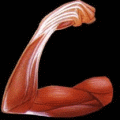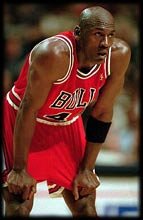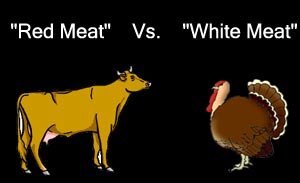As a way of presenting my argument, let me first draw a few parallels between two hypothetical training scenarios - the first is highly unlikely, the second is ubiquitous and all-too familiar. Both, however, are equally absurd.
Scenario One
You're trying to get in a decent serratus & scalene workout, but you're finding yourself increasingly annoyed by a body pump class in the aerobics room on the other side of the glass wall. Over the course of an hour, the participants are looking sloppier and sloppier as they try to keep up with the obscenely estrogenic soundtrack (which you've been trying to ignore for fear of developing breast tissue). "What's the point?" you wonder, watching the class going from crisp to wilted over the course of the sweat-fest. "They'll never grow any muscle doing that sloppercize class!
Scenario Two
 The next week, you're back in the gym performing a set of squats to failure. You reason to yourself that only an all-out assault on the bar will result in progress - no pain, no gain as they say. So you unrack the bar, step back to clear the rack, and go to war. The first 4 or 5 reps are pretty solid, but after that, you begin to slow down. Nevertheless, you manage to complete 12 reps. This is a personal record for you, but no need for congratulation: rep by rep, your fatigue levels escalate. And the more you fatigue, the less force you exert on the bar. The less force you exert, the less your training targets the fast twitch fibers and the more it targets the slow twitch fibers.
The next week, you're back in the gym performing a set of squats to failure. You reason to yourself that only an all-out assault on the bar will result in progress - no pain, no gain as they say. So you unrack the bar, step back to clear the rack, and go to war. The first 4 or 5 reps are pretty solid, but after that, you begin to slow down. Nevertheless, you manage to complete 12 reps. This is a personal record for you, but no need for congratulation: rep by rep, your fatigue levels escalate. And the more you fatigue, the less force you exert on the bar. The less force you exert, the less your training targets the fast twitch fibers and the more it targets the slow twitch fibers.
Oh, by the way - fast twitch fibers are so-named because they make you fast, while slow twitch fiber development slows you down. Now, what did you say your reason for strength training was??!!
OK, look - if you're feeling somewhat discouraged by the sudden realization that all the weight training you've done (for who knows how many years) is ineffective, take heart - you're not alone! Based on my experiences consulting with athletes for the past 20 years, I'd estimate that well over 99% of those who train with weights subscribe to the erroneous notion that the primary goal of training is to achieve a high level of fatigue.
If you're looking for membership in the 1% club, it's time for a paradigm shift. Here it is:
The effectiveness of training is not determined by the amount of fatigue it produces; but rather, by the degree to which it improves the skill or quality which is being trained.
In strength training (as in most other pursuits), the "quality" of a training session is defined and measured by how closely it approximates your maximum capabilities. For example, if an athlete can perform a power clean with 275 pounds for one rep and not two, this is called "1RM," or "single repetition maximum." This is your 100% quality benchmark for that exercise. In a strength training session, the closer you are to your 1RM, the higher the quality of that session. In another example, if your 1RM is 300 pounds and during a workout you lift 234 pounds, then you are training at 80% of 1RM, regardless of how many sets and reps you perform with that weight. Paradoxically, even a single repetition with 275 pounds is higher quality than an all-out set of 12 reps with 270 pounds, although the 12 reps will certainly result in greater fatigue.
Click Here To Calculate Your One Rep Max
Don't miss the point however: a certain amount of quantity is indeed necessary to achieve a good training effect. What we're suggesting is that quality should never be sacrificed for the sake of quantity. This certainly shouldn't be a foreign concept - how many times have you heard "Practice doesn't make perfect... perfect practice makes perfect." ? All we're doing is applying the same principle to strength training.
Speed Kills (The Competition, Not You)
OK, now that we're familiar with the concept of 1RM as the maximum quality benchmark in strength training, it's time to examine an important method of improving the quality (and therefore, training effect) of any given weight. However, doing so requires violating another dearly-held belief (something that most personal trainers live and die by):" lift weights slowly and under control. Now, the "under control" aspect of this advice is a truism of course - but lifting weights more slowly than necessary lowers quality, and here's why: 
For any given weight, more speed equals more tension. And by this point you can hopefully appreciate that more speed leads to better recruitment of fast-twitch muscle fiber - the heavy artillery responsible for elite-level athletic performance (please see the sidebar entitled: "Muscle Fiber Types").
Careful! You'll Poke Your Eye Out With That Thing!
But doesn't lifting weights quickly increase the chance of injury? My admittedly sarcastic answer to this question in seminars is "I don't know...does running, jumping, throwing or kicking fast increase the chance of injury?" I'm always amazed how athletes (and people in general) think nothing of executing powerful throws, jumps, kicks, and swings, yet feel the need to lift weights slowly due to fear of injury. The human body was literally designed to accelerate - think about it...the last time you lifted a 45 from the floor to the squat bar, did you lift it as slowly as you could, or did you accelerate it?
In any event, there's a more refined way of considering the issue of training safety:
Danger is relative to preparation: More stress to the tissues does statistically elevate your chance of injury, but it doesn't mean you'll get injured. Think about it this way - if your body can safely handle 1000 units of tension, then 400 units of tension poses a greater chance of injury than 300 units. But it still represents a minimal chance of injury. The whole point of weight training for athletes is to provide the body with a challenge that it could not experience otherwise. If you want to eliminate your chance of injury, you'll also need to eliminate the challenge, which also means saying "ciao" to the training effect.
Quality Versus Quantity
A recent television commercial which ran during the last Olympic games reflects our love of quantity: the camera zooms in on a fit-looking woman pounding out sit-ups on the track, as she counts "23, 24, 25..." Then cut to another athlete punching out a set of push-ups in a boxing gym, counting "39, 40, 41..." The commercial continues in this way as it follows several athletes repping out on various exercises to the backdrop of heroic music. By the end of the commercial, your hair is standing on end and you feel like driving to the gym immediately. However, the most critical aspect of training, the aspect that is fundamental to training success, is completely ignored: quality.
Despite what many athletes and coaches think, more reps at the same weight does not indicate a higher quality set. It indicates a higher quantity set.
Be Like Mike
 Compare the following examples:
Compare the following examples:
- Mike and Jason can both bench press 315 pounds for a single repetition.
- In one workout, Mike uses 282 pounds (90%) for 6 sets of 2 repetitions.
- Jason uses 220 pounds (70%) for 5 sets of 8 repetitions.
- End result: Mike gets stronger, despite doing less total work, because he employed higher quality weights in his workout.
- Of course, Jason feels more "fragged" after his workout, which gives him a false sense of confidence about his abilities.
- Mike, on the other hand, still feels quite fresh after his workout, and his sense of confidence is accurate, since his 1RM's are improving month by month. mike never seems to get stronger, but remains confident because he's almost always sore - a constant reminder that he's working hard.
Choose Your Method
Ultimately, there are essentially three methods of strength training available to athletes, as outlined by Dr. Vladimir Zatsiorsky in his excellent text Science and Practice of Strength Training:
1) Repeated Effort Method: A submaximal weight is lifted for several (typically 8-12) repetitions per set, either to complete muscular failure or close to failure. This is the method which (mistakenly) is almost exclusively used by many gym rats. The repeated effort method causes increases in muscle mass, but has a minimal effect on maximal strength, relative strength, and speed strength improvements (please see "Strength Qualities Required for High-Level Strength Performance.") It also causes post exercise muscle soreness, which can have a negative effect on skills training.
2) Maximal Effort Method: A maximal (or near maximal) weight is lifter for a small (typically 1-3) number of repetitions per set. This method leads to significant improvements in maximal strength, relative strength, and speed strength and minimal post exercise muscle soreness. The maximal effort method leads to less gains in lean muscle mass than the repeated effort method. For this reason, it is favored by competitive weightlifters, who must be as strong as possible without gaining bodyweight.
3) The Dynamic Effort Method: A light to moderate weight is moved with maximum speed. This method is used to improve the rate of force development (speed strength). As such, it is of enormous value to athletes who must overcome large loads (either their own body or an opponent's body) with great speed.
The singular point I'm trying to make in this discussion is that most athletes (including bodybuilders) need to minimize their use of the repeated effort method in favor of the maximal and dynamic effort methods of strength training. These two methods are what success coach Jeff Smith calls "major outcome activities," meaning, activities which have the largest positive impact on being able to experience your major outcome, or primary goal. These two methods have been used by speed and explosion athletes from a wide variety of sporting events for years, yet for some reason, martial artists are slow to adopt these proven methods.
Ultimately, hard work (by itself) doesn't cut the mustard in elite-level sport. When the last man is standing, no-one receives medals for working hard. Medals are awarded for being the best. If being the best is one of your major outcomes in life, I urge you to employ the the concepts I've presented in this article to your own training.
Coach Staley's Top Ten Stealth Strategies for Maximizing the Results of Your Strength Training
1) Never sacrifice quality for quantity. This is the first commandment for athletic success. Violate it and prepare to fail.
2) Target the weakest link. If you're naturally strong, train for speed and/or endurance. If you're naturally fast, train for strength.
3) For athletes, strength training is a supplementary, not a primary, activity. If time and energy are at a premium, focus your efforts on your sport practice sessions before supplementary training activities.
4) Minimize redundancy: Redundant systems are a great safety feature in aircraft design, but not such a good idea when it comes to program design. Since there are specific limits to one's time and energy (and since injury and overtraining are a constant threat to athletes and fitness enthusiasts alike), it makes sense to use that time and energy wisely.
 Thus, a fundamental premise of intelligent program design is that of minimizing redundancy. As an example, during a workout, if you decide upon 2-3 exercises for a single muscle, make the exercises as dissimilar as possible. In other words, if you perform two biceps exercises in the same workout, don't use standing barbell curls and standing EZ-bar curls - the two movements are almost identical save for the slight variation in hand position. Instead, a better choice might be single-arm 45-degree dumbbell incline curls and straight bar preacher curls. Now we have effectively reduced redundancy to a bare minimum.
Thus, a fundamental premise of intelligent program design is that of minimizing redundancy. As an example, during a workout, if you decide upon 2-3 exercises for a single muscle, make the exercises as dissimilar as possible. In other words, if you perform two biceps exercises in the same workout, don't use standing barbell curls and standing EZ-bar curls - the two movements are almost identical save for the slight variation in hand position. Instead, a better choice might be single-arm 45-degree dumbbell incline curls and straight bar preacher curls. Now we have effectively reduced redundancy to a bare minimum.
5) When switching to a more quality-based style of strength training, work your way to higher intensities gradually. If you typically perform 10-12 reps a set, don't immediately switch to maximum singles. Instead, spend some time in the 4-6 rep range for several weeks, and then continue toward higher levels of stress as your body becomes accustomed to harder training.
6) Terminate the training component when the quality of the performance erodes by 10% of more, NOT when you are completely unable to function!
7) Select strength training exercises on the basis of how well they train large numbers of muscles simultaneously, and also by how well they correspond to fundamental movement patterns. Some examples would be squats, deadlifts, and bench presses (and their variations), various types of pullups, lunges, and abdominal exercises.
8) Try to reduce your dependency on soreness. If feeling bad is your goal, sign up for a job as Lennox Lewis' sparring partner. If progress is your objective, make sure you perform gradually increasing workloads from workout to workout.
9) Avoid RES (Repetitive Error Syndrome): Don't continue to do workouts or programs that don't work. Do something else - ANYTHING else.
10) Do all of the above and pick up your medals!
Strength Qualities Required for High-Level Strength Performance Maximal Strength
Maximal strength is defined as the amount of musculoskeletal force you can generate for one all-out effort, irrespective of time or bodyweight.
This form of strength can be demonstrated or tested in the weight room during the performance of a maximal, single repetition lift. While only powerlifters need to maximize and demonstrate this type of strength in competition, all athletes need to develop absolute strength as a foundation for other bio-motor abilities such as speed strength, strength endurance, agility, and others.
Relative Strength
Whereas maximal strength refers to strength irrespective of bodyweight, relative strength is a term used to denote an athlete's strength per unit of bodyweight (his or her "pound for pound strength"). It can be used as a modifier for other categories of strength, such as speed strength or strength endurance. So, if two athletes of different bodyweights can power clean (a display of speed strength) 275 pounds, they have equal speed strength for that lift, but the lighter athlete has greater relative speed strength.
Athletes who compete in weight-class events depend heavily on relative strength, as do athletes who must overcome their bodyweight to accomplish a motor task (i.e., long jump, sprinting, etc.). Further, sports which have aesthetic requirements (figure skating, gymnastics, etc.) demand the development of strength without a commensurate gain in bodyweight.
Speed Strength
Speed strength is defined as work divided by time, where work is defined as force x distance. Therefore, speed strength is defined as force x distance, divided by time.
Muscle Fiber Types
Muscles are composed of a wide variety of fibers, which scientists classify according to how they function. Traditionally, three categories are used:
Type IIb: These are large diameter fibers capable of producing high levels of force at fast contraction speeds. Known as "fast-twitch" fibers, Type IIbs fatigue very quickly.
Type IIa: These fibers are much like hybrids between IIbs and Type I fibers. They have moderate force producing capacities and moder
Type I: These fibers are also known as "slow-twitch" fibers because they have small diameters, have fairly low force output characteristics, and high endurance capacity. 
As a familiar illustration, a turkey's "white meat" is actually composed of mostly fast-twitch muscle fiber, while the "red meat" is mostly slow-twitch muscle.
The important thing to remember is that in reality, there are not three, absolutely distinct types of fibers but rather a "spectrum." On the one end are the biggest, fastest, strongest fibers which require a very high tension to activate (hence, they are often referred to as "high threshold" fibers), and on the other end are the smallest, slowest, and weakest (but least fatigable) fibers, also called "low threshold" fibers, since it takes only small amounts of muscular tension to activate them.
Everyone is born with a certain proportion of fast- and slow-twitch muscle fiber, (called "fiber ratio") and this proportion tends to vary from muscle to muscle. For example, muscles like the pectorals, lats, hamstrings, and gastrocnemius tend to have a greater proportion of fast-twitch muscle fibers, while other muscles like the deltoids, abdominals, and soleus tend to have larger proportions of slow-twitch muscle fibers.
Training according to fiber type: My rule of thumb is, don't worry about things you can't change. If performance is your objective, train ALL your muscles to perform as they would have to in your sport event, regardless of whether or not they're fast or slow twitch dominant. If "hugeness" is what you're after, use a variety of set/rep schemes to maximally challenge the entire fiber-type spectrum in each muscle.
